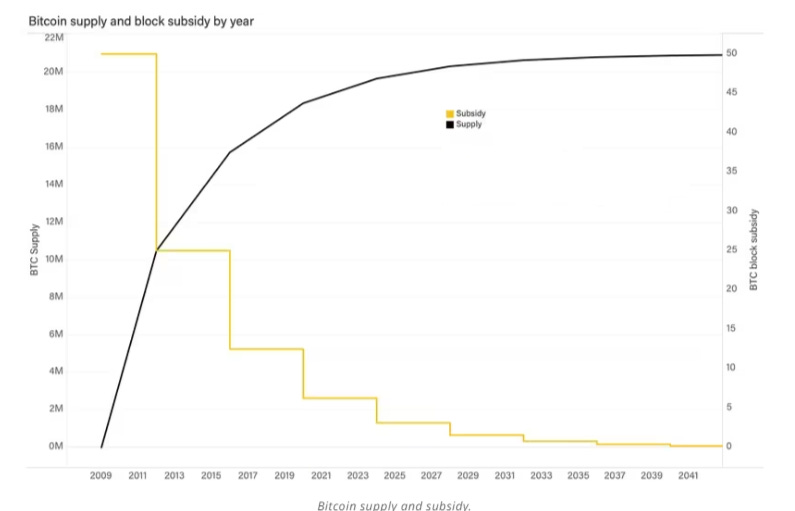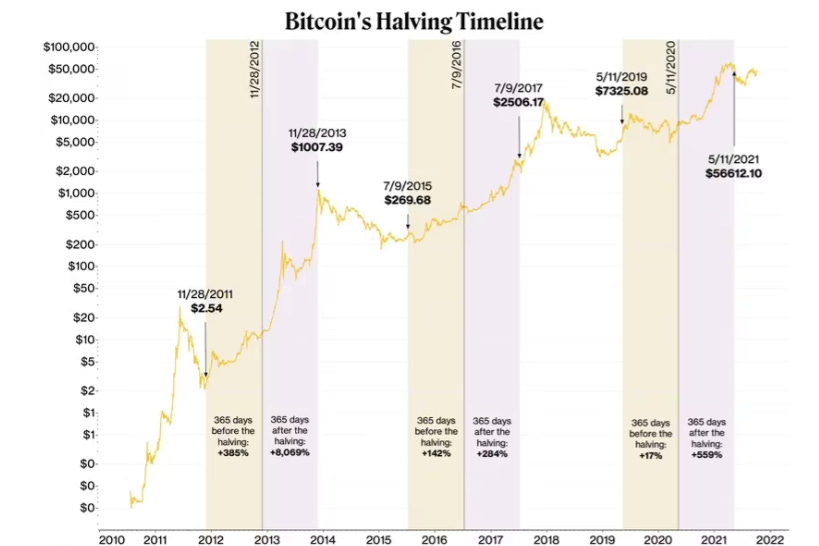- Blockletter
- Posts
- Crypto Explained: What is The Bitcoin Halving?
Crypto Explained: What is The Bitcoin Halving?
Demystifying Bitcoin's Future: Understanding Halving, Rewards, and Security in the Cryptocurrency Landscape
The Bitcoin halving, often dubbed "the halvening," stands as a pivotal event within Bitcoin's narrative. In May 2020, Bitcoin underwent its third halving, a cyclical occurrence ingrained in its protocol, where the issuance of new bitcoins every 10 minutes, known as block rewards, was slashed in half from 12.5 to 6.25 BTC. Predictable in its cadence, this event repeats approximately every four years, aligning with every 210,000 blocks.

This phenomenon garners significant attention, driven by the allure of potential wealth accumulation. With the reduction in the supply of newly minted bitcoins, juxtaposed against a stable or increasing demand, conjecture abounds regarding its impact on Bitcoin's valuation. Michael Dubrovsky, a co-founder of PoWx, a crypto research nonprofit, elaborates, "The theory is that there will be less bitcoin available to buy if miners have less to sell."
Beyond the immediate speculation surrounding price dynamics, the halving holds broader implications for Bitcoin's structural integrity. The block reward serves as a linchpin in Bitcoin's security framework, underpinning its decentralized architecture. However, as this reward diminishes over time and eventually reaches zero, concerns arise regarding the sustenance of the economic incentives vital for securing the network.
For those grappling with the intricacies of this intricate subject, here's a comprehensive breakdown.
Unveiling the Bitcoin Halving
The Bitcoin halving stands as a pivotal event in the cryptocurrency's lifecycle, intimately tied to the mechanism of new coin issuance. Here's a breakdown of what it entails:
New bitcoins come into existence through block rewards, which are the fruits of labor for "miners" utilizing sophisticated electronic equipment to validate transactions and secure the network. Roughly every four years, the total reward available to miners is halved, marking a significant milestone in Bitcoin's supply dynamics.

At its inception in 2009, successful miners were rewarded with 50 bitcoins every 10 minutes. Following three halvings, the current reward stands at 6.25 bitcoins every 10 minutes, showcasing the diminishing issuance rate over time.
This process continues until the total number of bitcoins in circulation reaches 21 million, a limit hardcoded into the system. Projections suggest this milestone may be reached around the year 2140, marking the culmination of Bitcoin's issuance schedule.
Unraveling the Bitcoin Distribution Schedule
The enigmatic figure or group behind Bitcoin's inception, known as Satoshi Nakamoto, remains shrouded in mystery. Though absent from the public eye since approximately a year post the software's release, their initial correspondence provides glimpses into their rationale for devising the Bitcoin distribution schedule.
In the aftermath of releasing the seminal Bitcoin white paper, Nakamoto contemplated the potential outcomes of their chosen monetary policy, which governs the issuance of new bitcoins. The deliberation revolved around scenarios of deflation or inflation, underscoring the complexity inherent in crafting a digital currency from scratch, particularly regarding its supply dynamics.
Their sparse elaboration on the chosen formula reflects pragmatism: "Coins have to get initially distributed somehow, and a constant rate seems like the best formula," they articulated.
In stark contrast to traditional state-issued currencies, where central banks wield considerable influence over monetary policy, Bitcoin operates on a predetermined supply schedule ingrained within its codebase. This unyielding framework, unlike its fiat counterparts subject to political maneuvering, underscores Bitcoin's scarcity, a defining feature that shapes its market value.
Moreover, Nakamoto engineered Bitcoin with a diminishing block reward over time, a departure from conventional monetary systems governed by central authorities. This deliberate design choice reflects a departure from the prevailing financial norms, accentuating Bitcoin's decentralized ethos.
Nakamoto's subtle nods to political motives, evidenced by the inclusion of a newspaper headline in Bitcoin's genesis block, hint at a broader ambition to challenge the hegemony of traditional financial institutions. By establishing a currency impervious to centralized control, Bitcoin embodies a potential paradigm shift in monetary governance, potentially diminishing the influence of banks and governments over economic policy.
In essence, Nakamoto's vision for Bitcoin transcends mere technological innovation, embodying a subtle yet profound critique of existing financial systems and a bold assertion of individual sovereignty in the digital age.
Exploring the Impact of Halving on Bitcoin's Price
The anticipation surrounding a Bitcoin halving primarily stems from the belief that it could trigger a surge in price, yet the outcome remains uncertain.
With three halvings under its belt, Bitcoin offers a historical lens through which we can gauge potential market reactions.

The first halving in 2012 served as a litmus test for Nakamoto's unconventional supply schedule. Initially, there was apprehension within the Bitcoin community about how the sudden reduction in rewards would reverberate through the network. Contrary to expectations, the price embarked on an upward trajectory shortly after the event.
The 2016 halving was met with fervent anticipation, underscored by live coverage from platforms like CoinDesk and Blockchain.com's countdown. While the day of the halving witnessed a brief price dip of 10 percent to $610, it swiftly rebounded to pre-halving levels.
Although the immediate impact on Bitcoin's price post-halving may seem muted, the ensuing year often reveals noteworthy developments. Some posit that the observed price hikes are delayed manifestations of the halving's influence. The theory posits that as the supply of Bitcoin diminishes, demand remains constant or increases, thus propelling prices upwards. Examining Bitcoin's price 365 days after the second halving, it surged by an impressive 284% to $2,506.
Similarly, the most recent halving showcased a bullish trend in Bitcoin's price a year post-event, surging by over 559%.
Why Miners Deserve Those Rewards: Keeping the Network Secure
Block rewards are the lifeblood of Bitcoin's security. As Hasu, a well-known anonymous researcher, explains, Bitcoin tackles two crucial challenges:
Who Owns What? Secured through cryptography, only the owner of a private key (like a secret PIN) can spend their Bitcoin.
When? This was a major hurdle before Bitcoin. Without a solution, people could easily double-spend their coins, essentially creating counterfeit money.
Block rewards are the answer. They incentivize miners to maintain order within the network. As Hasu explains, without these rewards, chaos would ensue. Miners with sufficient computing power could:
Double-spend coins
Block transactions
However, the reward system discourages such malicious behavior. If miners break the rules, they lose their block rewards.
"The system is designed to make it more profitable to play by the rules than to break them," explained Michael Dubrovsky, a co-founder of crypto research non-profit PoWx.
Put simply, miners lose money if they cheat. The more computing power dedicated to mining Bitcoin (hashrate), the harder it becomes to attack the network. As block rewards incentivize miners, more computing power goes towards Bitcoin, ultimately strengthening its security.
The Long Game: Security Concerns After the Halvings
The diminishing block rewards raise a critical question: what happens when they become negligible?
Miners, after all, require an incentive. Running powerful computers is no small feat, and electricity bills add up quickly. The reward system keeps them engaged in securing the network.

However, as Satoshi Nakamoto himself predicted, block rewards will eventually dwindle to nothing. Transaction fees are expected to take over as the primary source of miner income. These fees are optional, but users risk lengthy processing times if they don't pay any.
The concern lies in whether transaction fees will be sufficient. Nakamoto himself acknowledged this uncertainty, suggesting that transactions might become more expensive in the future to maintain network security.
"This cannot really work without very expensive transaction costs," explained Michael Dubrovsky of PoWx. Bitcoin's architecture limits the number of transactions it can process directly.
Another looming question is whether miners will find future, reduced block rewards enticing enough, even with transaction fees factored in.
"I don't foresee a significant security decline from this halving," said Hasu, "but things could get dicey in eight to twelve years."
Part of the challenge is the unknown true cost of network security. "We don't know the exact security level Bitcoin needs," argues Dubrovsky. He proposes a hypothetical scenario where the reward is gradually reduced until attacks become a threat, then increased to stop them. This approach, while disastrous for Bitcoin in its current form, highlights the potential consequences of dwindling rewards without alternative solutions.
Hasu remains hopeful that transaction fees will suffice, but emphasizes the importance of considering worst-case scenarios. He points to growing scrutiny from world leaders as a potential future threat.
"It's impossible to predict the future," acknowledges Hasu, "but for a system built to last a century, we need to be prepared." The worst-case scenario, he suggests, is a lack of significant growth in demand for block space, leading to near-zero block rewards and an inadequately secured network.